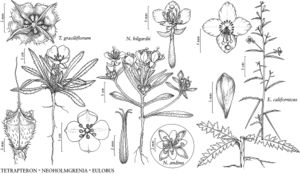Eulobus
Fl. N. Amer. 1: 514. 1840.
| Taxon | Illustrator ⠉ | |
|---|---|---|
 | Tetrapteron graciliflorum Neoholmgrenia hilgardii Neoholmgrenia andina Eulobus californicus |
Herbs, annual, [perennial, subshrubs], caulescent; with a taproot. Stems erect [to prostrate], unbranched or branched. Leaves cauline, sometimes also in basal rosette, alternate; stipules absent; sessile or petiolate; blade pinnatifid to lobed, [subentire]. Inflorescences open spikes, erect. Flowers bisexual, actinomorphic, buds erect; floral-tube relatively short, deciduous (with sepals, petals, and stamens) after anthesis, lined with a lobed, fleshy nectary disc [or with rounded, fleshy disc at base of style]; sepals 4, reflexed separately, in pairs, or as a unit, (rarely spreading); petals 4, yellow, fading orangish red, usually finely flecked with red near base; stamens 8, in 2 subequal series or epipetalous series shorter, anthers versatile, pollen shed singly; ovary 4-locular, stigma globose to cylindrical, surface wet and non-papillate. Fruit a capsule, straight or slightly curved [contorted], somewhat torulose or subterete, loculicidally dehiscent, midrib of each valve prominent; sessile. Seeds numerous, in 1 row per locule, narrowly obovoid, ± triangular in cross-section, finely papillose. = 7.
Distribution
sw United States, nw Mexico
Discussion
Species 4 (1 in the flora).
Eulobus is characterized by olive brown seeds with distinct purple spots, yellow petals with maroon flecks near the base, the distal part ultraviolet-reflective, leaves mostly lobed or pinnatifid, and capsules somewhat contorted or straight, and often sharply reflexed at maturity. R. A. Levin et al. (2004) included E. californicus and E. crassifolius (Greene) W. L. Wagner & Hoch (a species of Baja California, Mexico) in their molecular analysis and found Eulobus to be strongly supported as monophyletic; they also found that Eulobus plus (Chylismia plus Oenothera) formed a weakly supported clade. Reproductive features include: self-incompatible [E. crassifolius, E. sceptrostigma (Brandegee) W. L. Wagner & Hoch] or self-compatible [E. angelorum (S. Watson) W. L. Wagner & Hoch, E. californicus], flowers diurnal, outcrossing and pollinated mainly by small oligolectic bees (E. G. Linsley 1963b, 1973) or autogamous (P. H. Raven 1969).
Selected References
None.